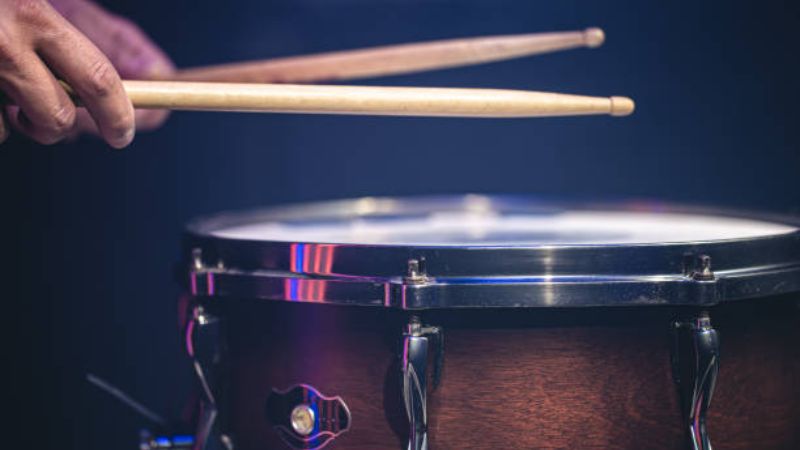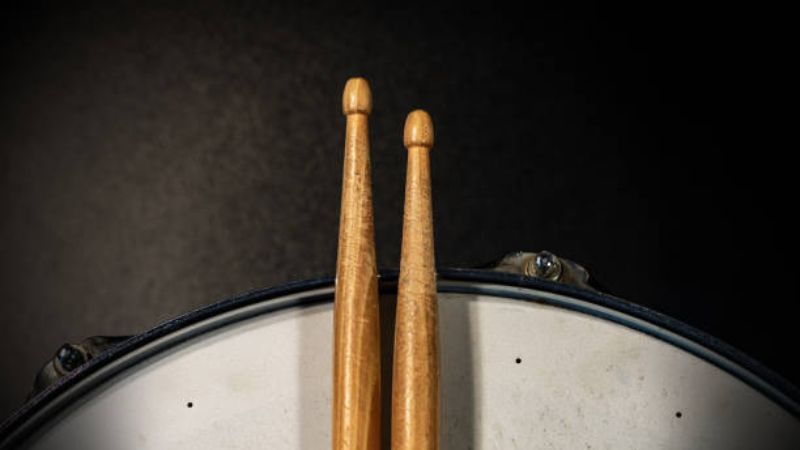Jazz drumming requires a unique blend of technical proficiency, creativity, and rhythmic sensibility.
The foundation of this art form lies in mastering drumstick grip and technique, which enables drummers to express the complex rhythms and nuanced dynamics characteristic of jazz.
This article will explore the essential components of jazz drumming technique, from fundamental grip styles to advanced concepts like comping and soloing.
By delving into these topics, aspiring jazz drummers can develop the skills necessary to navigate the diverse landscape of jazz music, from swing and bebop to fusion and Latin jazz.
Understanding Different Drumstick Grips
Drumstick grips form the cornerstone of jazz drumming technique.
The choice of grip influences a drummer’s ability to control dynamics, execute complex patterns, and achieve the desired tonal qualities.
For those seeking to improve their performance, the best jazz drumsticks can make a significant difference.
Five primary grip styles dominate the jazz drumming world:
- Matched Grip: Involves holding both sticks identically, palms facing down.
- Traditional Grip: Originates from marching drums, with the left hand using an underhand grip.
- German Grip: Utilizes palms facing directly downward, emphasizing finger control.
- French Grip: Employs thumbs on top of the sticks, facilitating quick, light playing.
- American Grip: Combines elements of German and French grips for versatility.
Each grip offers unique advantages and challenges, and many jazz drummers incorporate multiple grips to achieve diverse sounds and textures.
The Importance of Proper Grip in Jazz Drumming
Proper grip facilitates the execution of essential jazz drumming techniques.
A well-developed grip enhances stick control, allowing drummers to navigate complex rhythmic patterns with ease.


Moreover, it contributes to the development of a unique sound, as grip affects tonal quality and articulation.
Jazz legends like Buddy Rich and Elvin Jones demonstrated how mastery of grip can lead to groundbreaking innovations in drumming technique.
Essential Components of Jazz Drum Technique
Jazz drum technique comprises four key elements: hand coordination, finger control, wrist motion, and arm movement.
These components work in concert to produce the intricate rhythms and dynamic expressions characteristic of jazz drumming.
Hand coordination enables drummers to execute independent rhythms on different parts of the kit simultaneously.
Finger control allows for subtle manipulations of the stick, crucial for ghost notes and delicate cymbal work.
Wrist motion generates power and speed, particularly important in up-tempo bebop styles.
Arm movement provides the foundation for larger gestures and full-bodied playing, essential for creating dynamic contrast.
Table: Technique Components and Their Applications
| Component | Primary Function | Jazz Application |
|---|---|---|
| Hand Coordination | Independence | Polyrhythms, comping |
| Finger Control | Precision | Ghost notes, brush work |
| Wrist Motion | Power and Speed | Fast swing, bebop |
| Arm Movement | Dynamic Range | Accents, fills |
Body Mechanics and Posture for Jazz Drummers
Proper body mechanics underpin effective jazz drumming technique.
Correct posture facilitates fluid movement and prevents fatigue during extended playing sessions.
Key aspects of body mechanics include:
- Spine alignment
- Shoulder relaxation
- Hip positioning
- Foot placement
Jazz drummers should strive for a balanced, relaxed posture that allows for efficient energy transfer from the body to the drums.
Mastering the Jazz Drum Set
The jazz drum set consists of several components, each requiring specific techniques:
- Snare Drum: Demands precise stick control for articulate playing and brush techniques.
- Bass Drum: Requires foot technique for “feathering” and maintaining time.
- Toms: Utilize stick control for melodic fills and solos.
- Cymbals: Involve intricate stick work for ride patterns and accents.
Developing proficiency on each component contributes to a well-rounded jazz drumming skill set.


Developing Stick Control for Jazz
Stick control forms the bedrock of jazz drumming technique.
Rudiments, the building blocks of drumming, play a crucial role in developing this control.
Essential rudiments for jazz drumming include:
- Single stroke roll
- Double stroke roll
- Paradiddle
- Flam
- Drag
Advanced rudiments build upon these basics, incorporating more complex sticking patterns and rhythmic variations.
Stick control exercises, such as those found in George Lawrence Stone’s “Stick Control” book, provide a structured approach to improving technique.
Building Speed and Accuracy in Jazz Drumming
Speed and accuracy result from consistent practice and proper technique application.
To build these skills, jazz drummers should focus on:
- Gradual tempo increases
- Metronome work
- Relaxation techniques
- Efficient movement patterns
Table: Speed-Building Exercises
| Exercise | Purpose | Implementation |
|---|---|---|
| Single Stroke Roll | Build endurance | Gradually increase tempo |
| Paradiddle Variations | Improve coordination | Practice at various dynamics |
| Accent Patterns | Develop control | Apply to different rhythms |
Understanding and Achieving the Swing Feel
The swing feel lies at the heart of jazz drumming. It involves a subtle manipulation of timing, creating a lilt or “bounce” in the rhythm.
Key elements of the swing feel include:
- Triplet subdivision
- Emphasis on beats 2 and 4
- Subtle variations in note placement
Mastering the swing feel requires extensive listening and practice, as well as a deep understanding of jazz phrasing.
Exploring Different Jazz Drumming Styles
Jazz drumming encompasses various styles, each with unique characteristics:
- Bebop: Features fast tempos and intricate comping patterns.
- Swing: Emphasizes the ride cymbal and hi-hat, with a strong focus on timekeeping.
- Fusion: Incorporates elements from rock and funk, often utilizing odd time signatures.
- Latin Jazz: Blends Afro-Cuban rhythms with jazz harmony and improvisation.
Each style demands specific technical approaches and rhythmic sensibilities.
Essential Jazz Drumming Concepts
Jazz drumming revolves around four core concepts:
- Comping: Involves accompanying other musicians with rhythmic support.
- Soloing: Allows drummers to showcase their creativity and technical prowess.
- Fills: Provide transitions between musical sections and add excitement.
- Timekeeping: Forms the foundation of the ensemble’s rhythmic structure.
These concepts intertwine to create the dynamic and interactive nature of jazz drumming.
Developing Independence in Jazz Drumming
Independence enables jazz drummers to execute multiple rhythms simultaneously.
Developing this skill requires:
- Limb isolation exercises
- Polyrhythmic studies
- Ostinato patterns
Advanced independence allows for complex comping patterns and innovative solo ideas.
Groove Exercises for Jazz Drummers
Groove exercises help solidify a drummer’s sense of time and feel.
Effective groove exercises include:
- Basic swing pattern variations
- Bossa nova and samba rhythms
- Funk-influenced patterns
- Odd-time signature grooves
Regular practice of diverse grooves enhances a jazz drummer’s versatility and rhythmic vocabulary.


The Role of Dynamics in Jazz Drumming Technique
Dynamics play a crucial role in jazz expression.
Mastering dynamic control requires:
- Ghost note techniques
- Brush control
- Cymbal choking
- Varied stick heights
Effective use of dynamics contributes to a more nuanced and expressive performance.
Brush Techniques in Jazz
Brush techniques add textural variety to jazz drumming.
Key brush techniques include:
- Sweeping patterns
- Tapping and striking
- Circular motions
- Pull-and-push strokes
Mastering brush work expands a jazz drummer’s tonal palette and enhances their ability to play in quieter settings.
Famous Jazz Drummers and Their Techniques
Studying renowned jazz drummers provides insight into advanced techniques and innovative approaches.
Notable figures include:
- Buddy Rich: Known for his incredible speed and technical prowess
- Elvin Jones: Pioneered polyrhythmic approaches in jazz
- Max Roach: Innovated bebop drumming and melodic soloing
- Tony Williams: Revolutionized jazz fusion drumming
Analyzing these drummers’ techniques can inspire new approaches to jazz drumming.
Essential Drumming Accessories for Jazz Drummers
Key accessories for jazz drummers include:
- Brushes
- Hot rods
- Practice pads
- Metronome
- Drum keys
These tools facilitate practice and expand tonal options in performance settings.


Practice Routines for Improving Jazz Drumming Technique
Effective practice routines accelerate skill development.
A balanced routine should include:
- Warm-up exercises
- Rudiment practice
- Groove work
- Independence exercises
- Transcription and analysis
Consistent, focused practice leads to significant improvements in technique and musicality.
Overcoming Common Challenges in Jazz Drumming Technique
Common challenges in jazz drumming include:
- Maintaining consistent time
- Developing limb independence
- Mastering brush techniques
- Improvising coherent solos
Overcoming these challenges requires patience, dedicated practice, and often, guidance from experienced instructors.
Conclusion: Putting It All Together – The Path to Mastery
Mastering jazz drumming technique is a lifelong journey that demands dedication, creativity, and a deep love for the music.
By focusing on proper grip, developing essential techniques, and exploring various jazz styles, drummers can cultivate a unique voice within the rich tradition of jazz.
Remember, the ultimate goal is not just technical proficiency, but the ability to express oneself fluently and contribute meaningfully to the collective musical conversation that defines jazz.

